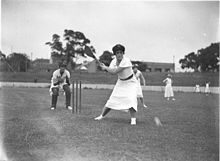
Vigoro is a team sport, played mainly by women in Australia, that originally combined elements of cricket and tennis, although in its current form it may be more similar to cricket and baseball. [1]

Vigoro is a team sport, played mainly by women in Australia, that originally combined elements of cricket and tennis, although in its current form it may be more similar to cricket and baseball. [1]
The game was invented in 1901 by Englishman John George Grant. [lower-alpha 1] [1] In the original version tennis rackets were used and the wicket consisted of six stumps. On 17 October 1902, a match was played before the MCC committee at Lord's. [3] An eleven led by real tennis and rackets player Eustace Miles, and including Wimbledon champions Laurence and Reginald Doherty, defeated the opposition, led by Surrey batsman Bobby Abel. Miles' team led after the first innings by 73 to 18 runs and won by an innings after Abel's team made only 39 runs in the second innings. [4] That same month the game was also played at Crystal Palace. [5] Games were also played that year, and in 1903, at London's Queen's Club. [1] In England interest in the game died down after a few years but it managed to gain a foothold in Australia where it was introduced during World War I. A key figure in the promotion of the game in Australia was Ettie Dodge, who was President (1919–66) of the New South Wales Women's Vigoro Association and foundation president (1932–66) of the All Australian [Vigoro] Association. Ettie's husband had met John George Grant in England. When the game was introduced to New South Wales schools in the 1920s, Dodge & Co. began selling vigoro equipment. Grant died in 1927 and bequeathed the trademark and copyright of the game to Ettie. [6]
Vigoro is played on a pitch which shall be no shorter than 17.68 m [58'], [7] which is slightly shorter in length than a cricket pitch. The balls are much lighter than those for cricket, and the bat has a different shape with a long handle resembling the shape of a paddle. [8] [9]
There are two teams of 12 players which will bat and field two innings each (except in the event that a team wins with an innings in hand). The aim of the game is for a team to score more runs than the opposition team.
There are no overs and the batsmen bat from one end only. Two bowlers bowl alternately and can incorporate any type of "throwing" action as long as the ball is released above the shoulder (i.e. not underarm).
If the ball is hit forward of the crease, the batter must run. [10]
A run is completed each time both batters safely make it to the crease at the opposite end of the pitch. Fours and sixes also apply where the batter hits the ball past the boundary markers. In addition to shots made off the bat, byes and leg-byes add to the team's score.
Players may be dismissed by the same methods as in cricket – bowled, caught, run out, stumped, leg before wicket, hit wicket, handled ball and hit the ball twice.
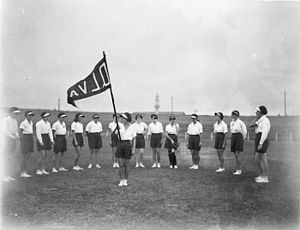
Teams from Tasmania, New South Wales and Queensland compete annually for the All Australian Vigoro Titles. These teams compete across four divisions – State (Senior) One and Two, Veterans and Juniors.
| Year | Host State | Division Winners | |||
|---|---|---|---|---|---|
| State 1 | State 2 | State Juniors | State Veterans | ||
| 2011 | NSW | NSW | NSW | Queensland | NSW |
New South Wales, Tasmania and Queensland [11] are the only States in Australia which host local competitions.
The 2010 Australian Vigoro Titles were held in Bendigo, the first time they had been contested in Victoria. [12]
The ABC reported 4 vigoro associations continued to play in 2022. [13]

Fielding in the sport of cricket is the action of fielders in collecting the ball after it is struck by the striking batter, to limit the number of runs that the striker scores and/or to get a batter out by either catching a hit ball before it bounces, or by running out either batter before they can complete their current run. There are a number of recognised fielding positions and they can be categorised into the offside and leg side of the field. Fielding also involves trying to prevent the ball from making a boundary where four "runs" are awarded for reaching the perimeter and six for crossing it without touching the grass.

Backyard cricket, also known as bat ball, street cricket, beach cricket, corridor cricket, garden cricket,gully cricket and box cricket, is an informal variant of cricket. It is typically played in various non-traditional venues such as gardens, backyards, streets, parks, carparks, beaches, and any area not specifically designed for the sport.

Leg before wicket (lbw) is one of the ways in which a batter can be dismissed in the sport of cricket. Following an appeal by the fielding side, the umpire may rule a batter out lbw if the ball would have struck the wicket but was instead intercepted by any part of the batsman's body. The umpire's decision will depend on a number of criteria, including where the ball pitched, whether the ball hit in line with the wickets, the ball's expected future trajectory after hitting the batsman, and whether the batsman was attempting to hit the ball.
The Laws of Cricket is a code that specifies the rules of the game of cricket worldwide. The earliest known code was drafted in 1744. Since 1788, the code has been owned and maintained by the private Marylebone Cricket Club (MCC) in Lord's Cricket Ground, London. There are currently 42 Laws, which describe all aspects of how the game is to be played. MCC has re-coded the Laws six times, each with interim revisions that produce more than one edition. The most recent code, the seventh, was released in October 2017; its 3rd edition came into force on 1 October 2022.

The wicket-keeper in the sport of cricket is the player on the fielding side who stands behind the wicket or stumps being watchful of the batsman and ready to take a catch, stump the batsman out and run out a batsman when occasion arises. The wicket-keeper is the only member of the fielding side permitted to wear gloves and external leg guards. The role of the keeper is governed by Law 27 and of the Laws of Cricket.
In the game of cricket, the cricket pitch consists of the central strip of the cricket field between the wickets. It is 22 yd (20.12 m) long and 10 ft (3.05 m) wide. The surface is flat and is normally covered with extremely short grass, but can be completely dry or dusty soil with barely any grass or, in some circumstances, made from an artificial material. Over the course of a cricket match, the pitch is not repaired or altered other than in special circumstances - meaning that it will change condition. Any grass on the pitch in the game's first over, for example, may have disappeared by twentieth over due to wear.
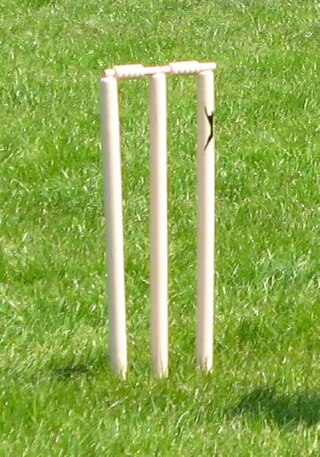
In cricket, the term wicket has several meanings:

This is a general glossary of the terminology used in the sport of cricket. Where words in a sentence are also defined elsewhere in this article, they appear in italics. Certain aspects of cricket terminology are explained in more detail in cricket statistics and the naming of fielding positions is explained at fielding (cricket).

In cricket, a no-ball is a type of illegal delivery to a batter. It is also a type of extra, being the run awarded to the batting team as a consequence of the illegal delivery. For most cricket games, especially amateur, the definition of all forms of no-ball is from the MCC Laws of Cricket.

Indoor cricket is a variant of and shares many basic concepts with cricket. The game is most often played between two teams each consisting of six or eight players.

In cricket, batting is the act or skill of hitting the ball with a bat to score runs and prevent the loss of one's wicket. Any player who is currently batting is, since September 2021, officially referred to as a batter —regardless of whether batting is their particular area of expertise. Batters have to adapt to various conditions when playing on different cricket pitches, especially in different countries; therefore, as well as having outstanding physical batting skills, top-level batters will have quick reflexes, excellent decision-making skills, and be good strategists. Although batsman is still widely used.

In cricket, a dismissal occurs when a batter's innings is brought to an end by the opposing team. Other terms used are the batter being out, the batting side losing a wicket, and the fielding side taking a wicket. The ball becomes dead, and the dismissed batter must leave the field of play for the rest of their team's innings, to be replaced by a team-mate. A team's innings ends if ten of the eleven team members are dismissed. Players bat in pairs so, when only one batter remains who can be not out, it is not possible for the team to bat any longer. This is known as dismissing or bowling out the batting team, who are said to be all out.

In cricket, a run is the unit of scoring. The team with the most runs wins in many versions of the game, and always draws at worst, except for some results decided by the DLS method, which is used in rain-shortened limited-overs games when the two teams have had a different number of opportunities to score runs.
Baseball and cricket are the best-known members of a family of related bat-and-ball games. Both have fields that are 400 feet (120 m) or more in diameter between their furthest endpoints, offensive players who can hit a thrown/"bowled" ball out of the field and run between safe areas to score runs (points) at the risk of being gotten out, and have a major game format lasting about 3 hours.
In cricket, the batting order is the sequence in which batters play through their team's innings, there always being two batters taking part at any one time. All eleven players in a team are required to bat if the innings is completed.
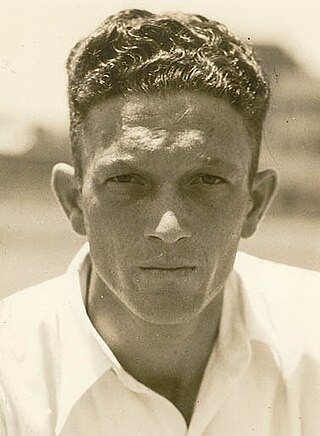
Donald Tallon was an Australian cricketer who played 21 Test matches as a wicket-keeper between 1946 and 1953. He was widely regarded by his contemporaries as Australia's finest ever wicket-keeper and one of the best in Test history, with an understated style, an ability to anticipate the flight, length and spin of the ball and an efficient stumping technique. Tallon toured England as part of Don Bradman's Invincibles of 1948 and was recognised as one of the Wisden Cricketers of the Year in 1949 for his performances during that season. During his Test career, Tallon made 58 dismissals comprising 50 catches and 8 stumpings.

Stumped is a method of dismissing a batter in cricket, in which the wicket-keeper puts down the striker's wicket while the striker is out of their ground. It is governed by Law 39 of the Laws of Cricket.
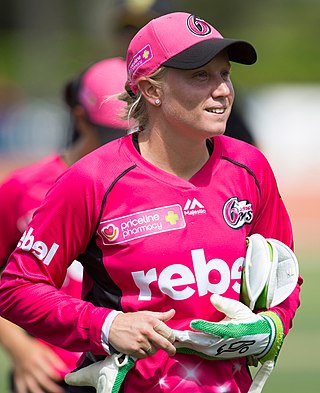
Alyssa Jean Healy is an Australian cricketer who plays and captains the Australian women's national team. She also plays for New South Wales in domestic cricket, as well as the Sydney Sixers in the WBBL. She made her international debut in February 2010.

Cricket is a bat-and-ball game played between two teams of eleven players on a field at the centre of which is a 22-yard (20-metre) pitch with a wicket at each end, each comprising two bails balanced on three stumps. Two players from the batting team stand in front of either wicket, with one player from the fielding team bowling the ball towards the striker's wicket from the opposite end of the pitch. The striker's goal is to hit the bowled ball and then switch places with the nonstriker, with the batting team scoring one run for each exchange. Runs are also scored when the ball reaches or crosses the boundary of the field or when the ball is bowled illegally.
Wicket or wicket ball was an American form of cricket played up until the 1800s.